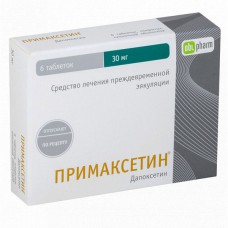Expiration date: 01/2026
Pharmacological action
Pharmacotherapeutic group
A treatment for premature ejaculation.
ATX code: G04BX14
Pharmacological properties
Pharmacodynamics
It is assumed that the mechanism of action of dapoxetine in premature ejaculation is associated with inhibition of serotonin reuptake by neurons, followed by increased action of the neurotransmitter on pre - and postsynaptic receptors.
The mechanism of ejaculation is regulated mainly by the sympathetic nervous system. Postganglionic sympathetic nerve fibers Innervate the seminal vesicles, VAS deferens, prostate, urethral and bladder neck muscles, causing them to contract in a coordinated manner to achieve ejaculation. Dapoxetine affects the ejaculation reflex, increasing the latency period and reducing the duration of reflex impulses of the perineal ganglion motor neurons. The stimulus that triggers ejaculation is generated in the spinal reflex center, which is controlled through the brain stem by several brain nuclei, including the preoptic and paraventricular ones.
Pharmacokinetics
Suction
Dapoxetine is rapidly absorbed, and the maximum plasma concentration (Cmax) is reached 1-2 hours after taking the drug. Absolute bioavailability is 42% (range 15-76%). After a single oral intake of dapoxetine on an empty stomach in doses of 30 mg and 60 mg, the maximum concentration of the substance in the blood plasma is 297 ng / ml (after 1.01 hours) and 498 ng/ml (after 1.27 hours), respectively.
Taking fatty foods moderately reduces the Cmax of dapoxetine (by 10%) and increases the AUC (the area under the "concentration-time" curve) and the time to reach the maximum concentration in blood plasma by 12%. However, the degree of absorption of dapoxetine does not change. These changes are not clinically significant. Drug Primaxin® can be taken with or without food.
Distribution
More than 99% of dapoxetine is bound to plasma proteins in vitro. The active metabolite - desmethyldapoxetine-binds to plasma proteins by 98.5%. Dapoxetine is rapidly distributed throughout the body with an average equilibrium distribution volume of 162 l. when administered intravenously in humans, the average half-life in the initial, intermediate and terminal phases of excretion is 0.10, 2.19 and 19.3 hours, respectively.
Metabolism
In vitro studies suggest that dapoxetine is metabolized by many liver and kidney enzymes, especially CYP2D6, CYP3A4, and flavin-containing renal monooxygenase (FMO1). In a clinical study that studied the metabolism of 14C-dapoxetine, dapoxetine after oral administration was actively metabolized mainly by n-oxidation, N-demethylation, hydroxylation of the naphtho group, glucuronidation, and addition of the sulfo group. After oral administration, signs of presystemic metabolism in the liver were found. The main components circulating in the blood plasma were intact dapoxetine and dapoxetine-N-oxide. In vitro studies have found that dapoxetine-N-oxide is inactive. In addition, it was found desmetiltamoksifen and didesmethylvenlafaxine in an amount of less than 3% of the total number of circulating metabolites of dapoxetine. In an in vitro study, it was found that desmethyldapoxetine is comparable in activity to dapoxetine, and didezmethyldapoxetine is approximately 2 times less active than dapoxetine. The exposure (AUC and Cmax) of unbound desmethyldapoxetine was 50% and 23% of unbound dapoxetine, respectively. Breeding
Dapoxetine metabolites are excreted mainly in the urine as conjugates. Unchanged active substance is not detected in the urine. Dapoxetine is rapidly eliminated, as evidenced by the low concentration of the substance in the blood plasma (less than 5% of the maximum) 24 hours after taking the dose. With daily intake, the accumulation of the substance in the body is minimal. When taken orally, the final half-life is approximately 19 hours.
Special patient groups
Race
A single dose of dapoxetine at a dose of 60 mg did not reveal a statistically significant difference in indicators in Europeans, persons of the black race, Latin Americans and persons of the Asian race. Comparison of the pharmacokinetics of dapoxetine in Europeans and Japanese showed higher values of Cmax and AUC, in the latter (by 10-20%) due to lower body weight. A higher level of systemic exposure is unlikely to cause a significant difference in clinical effect.
Elderly patients (65 years and older)
A single dose of dapoxetine at a dose of 60 mg did not reveal a significant difference in pharmacokinetics (Cmax, AUC, Tmax) in healthy older men and younger men.
The average AUC values of dapoxetine and the final half-life were higher, respectively, by 12% and 46% in older men compared to younger men.
Impaired kidney function
A single dose of dapoxetine at a dose of 60 mg did not reveal a relationship between creatinine clearance and the Cmax or AUC of dapoxetine in patients with weak (creatinine clearance of 50-80 ml / min), moderate (creatinine clearance of 30 to
Impaired liver function
In patients with mild hepatic impairment, the pharmacokinetics of dapoxetine and desmethyldapoxetine did not change. In patients with moderate hepatic impairment (child-Pugh class B), the Cmax and AUC of unbound dapoxetine were increased by 55% and 120%, respectively. The Cmax of the unbound active fraction of dapoxetine was unchanged, and the AUC was increased by 2 times.
In patients with severe hepatic impairment, the Cmax of unbound dapoxetine was unchanged, and the AUC of unbound dapoxetine was increased by more than 3 times. The AUC of the active fraction was also increased several times.
CYP2D6 polymorphism
The plasma concentration of dapoxetine after a single dose of Primaxetin® at a dose of 60 mg in patients with low CYP2D6 activity was higher than in patients with high CYP2D6 activity (Cmax by about 31%, AUC by about 36%). Similarly, the Cmax of desmethyldapoxetine in patients with low CYP2D6 activity was increased by 98%, and the AUC was increased by 161%. The average final half-life of dapoxetine was increased by 2.4 hours in patients with low activity of the CYP2D6 isoenzyme compared to patients with high activity of the CYP2D6 isoenzyme. The Cmax of the active fraction of dapoxetine was increased by - 46%, and the AUC by-90%. This increase may be accompanied by an increased frequency and severity of dose-dependent adverse events. The safety of Primaxetin® in patients with low CYP2D6 activity may be questionable when taking other drugs that can inhibit the metabolism of dapoxetine, in particular, active and moderately active CYP3A4 inhibitors.
Plasma concentrations of dapoxetine and desmethyldapoxetine are expected to be reduced in patients with ultra-high CYP2D6 activity.
Indications
Primaxetin® is intended for the treatment of premature ejaculation in men aged 18 to 64 years.
Contraindications
- Hypersensitivity to dapoxetine hydrochloride or any other component of the drug.
- Severe heart diseases (for example, NYHA class II-IV heart failure, cardiac conduction disorders (2-3 degree atrioventricular conduction block or sinus weakness syndrome) in the absence of a permanent pacemaker, severe coronary heart disease or valvular apparatus damage).
- Simultaneous administration of monoamine oxidase inhibitors (MAO-I) and administration within 14 days after discontinuation of their use. Similarly, MAO-AND cannot be taken for 7 days after discontinuation of the drug Primaxin®.
- Simultaneous administration of thioridazine and within 14 days after discontinuation of its use. Similarly, thioridazine should not take for 7 days after discontinuation of the drug Primaxin®.
- Simultaneous administration of serotonin reuptake inhibitors (selective serotonin reuptake inhibitors-SSRIs), serotonin and norepinephrine reuptake inhibitors and tricyclic antidepressants and other drugs with serotonergic effects (for example, L-tryptophan, tryptans, tramadol, linezolid, lithium, Hypericum perforatum) and within 14 days after discontinuation of these drugs. Similarly, these drugs can not be taken within 7 days after discontinuation of the drug Primaxin®.
- Simultaneous administration with active CYP3A4 inhibitors, such as ketoconazole, Itraconazole, ritonavir, saquinavir, telithromycin, nefazodone, nelfinavir, atazanavir, etc.
- Moderately severe and severe violations of liver function.
- Severe renal impairment.
- Children and teenagers under 18 years of age.
- Lactase deficiency, lactose intolerance, glucose-galactose malabsorption.
If there is a history of established or suspected orthostatic hypotension, as well as a history of mania/hypomania or bipolar disorder, treatment with Primaxetin®should be avoided.
With caution
- mild or moderate renal impairment,
- concomitant use with potent inhibitors of isoenzyme CYP2D6 and moderate inhibitors of CYP3A4 in patients with genotype low activity isozyme CYP2D6, and patients with high activity of izofermenta CYP2D6 (in combination with moderate inhibitors of CYP3A4),
- simultaneous use with drugs that affect platelet aggregation and anticoagulants due to the risk of bleeding.


